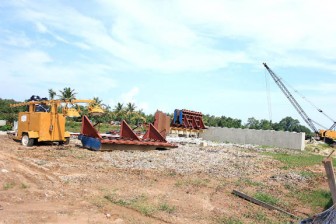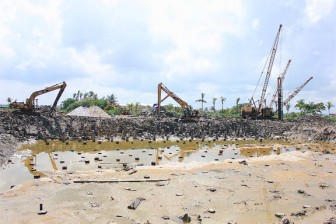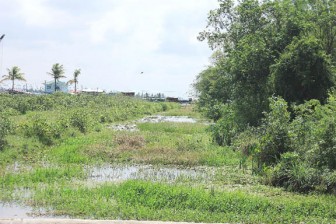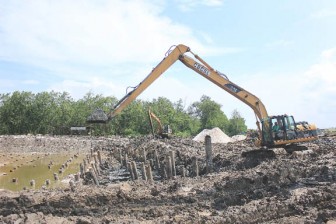-contractors challenge findings
Prominent engineers Malcolm Alli and Charles Sohan have sounded alarm bells over substandard work on the Hope Canal Project and have urged an independent review but the contractors are dismissing their concerns, saying their assessment of the situation is misleading.
“What we observed with respect to project activities, quality control and the contractors’ abilities to organize and execute the work to complete their contracts on time was not very encouraging,” Alli and Sohan wrote in a letter published in yesterday’s edition of the Stabroek News and which was based on a recent site visit to assess construction progress.
As a result of their findings, they urged Minister of Agriculture Dr Leslie Ramsammy to order an independent mid-term review of the project to assess progress with respect to the implementation of project activities focusing on the project implementation plan, its progress in achieving project outcomes, expenditures and the disbursement schedule. “The review will show how skewed the [National Drainage and Irrigation Authority]/consulting engineers were regarding the timely completion of project works and their indifference to costs and the auxiliary works required to make the system functional,” they said. “There can be no doubt that Dr Ramsammy… has been grossly misled that come June 2013 the Hope Canal project will be completed and become functional.”

The Hope Canal has four aspects: over 10km of channel from the East Demerara Water Conservancy, a bridge across the public road, a conservancy head regulation with three gates, and an outfall at the canal’s Atlantic exit, which will comprise eight gates. The canal’s excavation is being done by NDIA, with BK International, DIPCON Engineering and Courtney Benn Contracting Services constructing the other three components.
Among the findings of Alli and Sohan was that work done on the Weir discharge structure across the sea defence indicates that only about 15% of contract work has been completed to date. They said that based on the contractor’s performance so far, it is unlikely that the structure will be completed and become functional before 2014. “Excuses given such as the late delivery of materials, equipment failure and transportation difficulties all within his ambit are not severe contingencies to relieve the contractor of his contractual obligations to complete the Weir within the specified time-frame,” they said.
Drifting piles

Alli and Sohan also point out that the timber piles driven show that many of them are “out of plumb,” saying that they are drifting by as much as three feet. “The northern row of driven perimeter steel sheet piling shows that some of them have listed eastwards by as much as 15 degrees, indicating that they have been driven with inadequate guide support and their toes have probably slipped out of the interlocking grooves,” they note, while adding that the driven out-of-plumb timber piles may have been broken at the splices and therefore their bearing capacity compromised.
They said that the engineer responsible for observing materials and completed work to evaluate their compliance with the plans, specifications and design should have recognized these problems and instructed the contractor to take remedial measures to correct the sub-standard work. “The Minister of Agriculture/NDIA engineers during their recent visit to the site must have seen that the piles were being driven out of alignment, but apparently they took no action to remedy the situation, continue to allow things to slide while the contractor goes about his daily routine executing sub-standard work,” they added.

Efforts made by Stabroek News to contact the NDIA for a comment yesterday were unsuccessful, however, on-site engineers, who asked not to be named, challenged Alli and Sohan’s findings. One engineer stated that the piles were slanted due to earth movement. The man explained that two trenches once occupied the area where works are being carried out and that when works started the entire area was filled up to facilitate construction. He also said that tree bark and water pockets still remain beneath the earth making it quite unstable.
In addition to this impediment, the engineer stated that some of the timber piles could not be pile-driven the full 120ft into the earth due to resistance provided by what is known as “cemented sand.” Instead, he added, some of the piles could only be driven to depths of 110ft, 112ft, 113ft and 115ft. Another engineer stated that the soil surrounding the slanted piles still has to be excavated so that they can be cut to complete the foundation. He added that once cut, the slanting portions will be removed, eliminating the problem.
The on-site engineers also said that of the piles to be driven, more than 90% of them have already been driven, leaving just over 100 to be taken care of.
Weeds
Alli and Sohan also listed “weeds, which have taken over about 40% of the canal’s waterway” as “a major problem developing in the unfinished canal.” They estimated that within six months, if no action is taken, the entire waterway will be covered with weeds. “Their presence will severely restrict flow and negate the objective of discharging floodwater efficiently from the conservancy. Cost for their removal and continual maintenance will be an expensive exercise which NDIA is still to estimate and budget for,” they said, while pointing out that the bushes growing profusely on the embankments will also have to be controlled by regular maintenance.
Upon visiting the site, Stabroek News was able to confirm that the waterways were indeed clogged to a significant extent by weeds and that both banks of the canal were overtaken with heavy vegetation. The western bank, in particular, was rich with thick vegetative growth, including trees over 10ft in height.
Another concern raised by Alli and Sohan is the design and supervision of construction of the structure, which they noted requires some 520 timber piles 120 ft long based on the design of the foundation. “Of necessity the piles have to be spliced and the splicing of timber piles in general is never recommended because of the difficulty to keep the piles plumb and prevent cracking and splitting during driving,” they said. Further, they argue that the design should have been reviewed by an independent consultant to check whether the structure was not over-designed, and particularly the requirement for what appears to be “an excessive number of piles to support the structure.” Prior to construction, they added, test piles should have been driven and loaded to determine the length and number of piles required to adequately support the structure. They also noted that from experience of previously designed and built structures under similar soil conditions, such as the 7-door Weir across the Abary River, “timber piles were not necessary to support the structure since the soil at that elevation could safely support the imposed loads.”

The canal is about 50% completed and not 83% as claimed, Alli and Sohan added. They found that about 30% of the canal remains to be dug and re-dug to final bed grade and about 80% of its embankments have to be raised to design elevation, compacted, trimmed, shaped and strengthened with geo-textile fabric. Added to that, they said construction of the embankments between the Crown and Conservancy Dams is in a state of flux as the consultants and the NDIA contemplate how the geo-textile fabric stored outside the Hope Estate Office should be installed to achieve the design objectives. “It is worth noting that during our visit the pegasse built eastern embankment of the canal about 1 km north of the Head Regulator site was on fire, burning uncontrollably, and will probably compromise the geo-textile fabric if installed,” they added.
Alli and Sohan also said work on the head regulator is about 20% completed and piling is expected to be finished early in the new year. It is unlikely that this structure will be completed and be functional before the end of 2013, they, however, found.
The road bridge, they added, appears to be progressing slowly, “with an untidy work site, improper storage of material/equipment and signs of a disorganized work plan.” They also said some of the pre-stress units being installed on the bridge show changes from the original design, and therefore certified test reports should be available to confirm their strength requirements.
The Hope Canal is a US$15Million relief channel at the East Demerara Water Conservancy aimed at resolving the flooding usually experienced in the Mahaica, Mahaicony and Abary areas annually during the rainy seasons.
The canal is supposed to function as an alternative to utilizing the Lama Stop Off and Maduni Sluice, whose use also led to excessive flooding in those areas.




